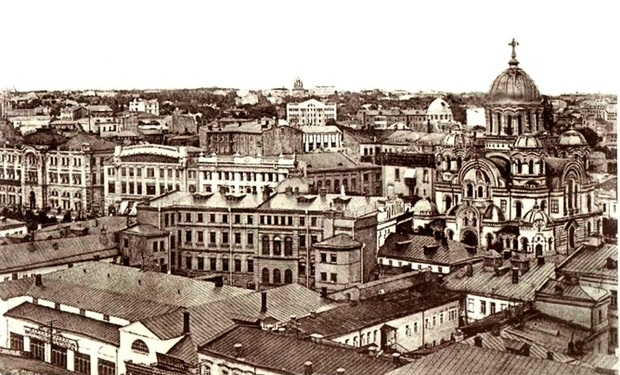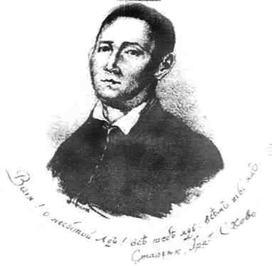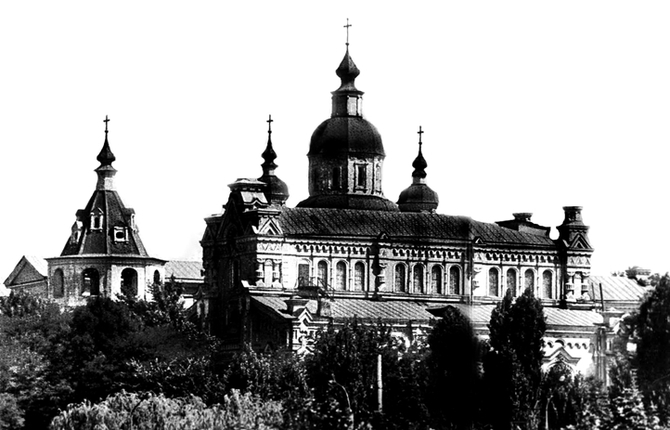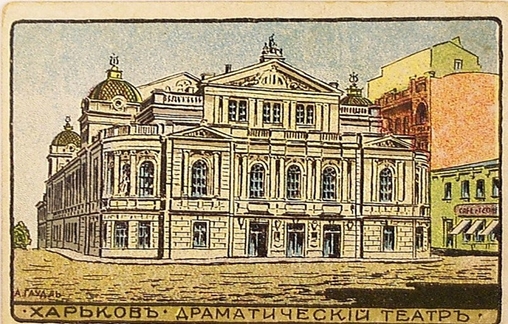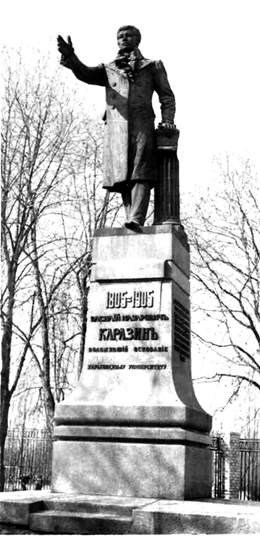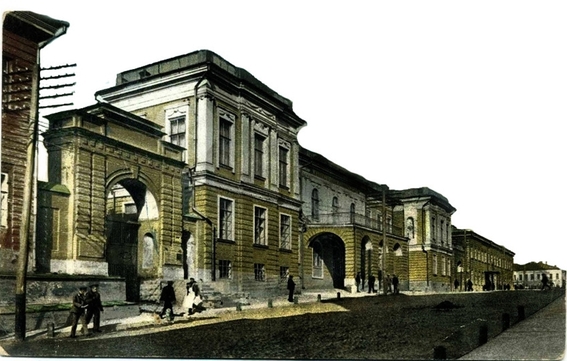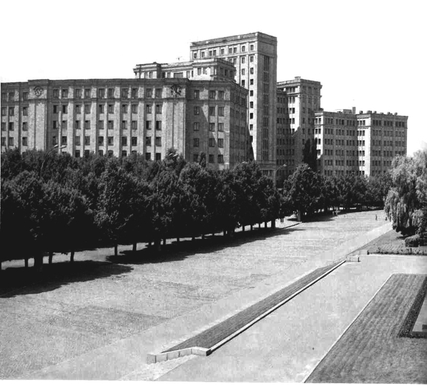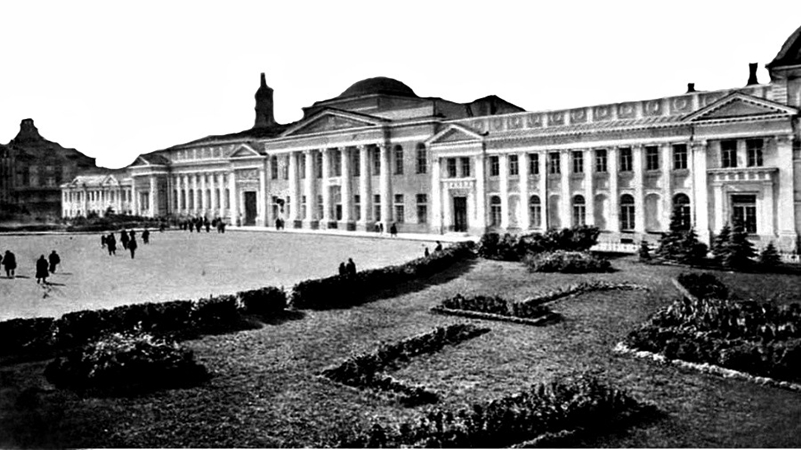UDC:78(477.54)"17/18"
37.014(477.54)"17/18"
COBISS.SR-ID 221745164
Received:04.Oct.2015./
Revised:08.Feb.2016./
Accepted:15.Feb.2016.
#5
GENESIS OF KHARKOV MUSIC CULTURE
IN THE HIGHLIGHT OF THE CITY’S EDUCATION AND CONCERT LIFE FORMATION
Olena Kononova
National I.P. Kotyarevsky University of Arts, Kharkov (Ukraine)
e-mail: [email protected]
National I.P. Kotyarevsky University of Arts, Kharkov (Ukraine)
e-mail: [email protected]
|
Citation: Kononova, Olena. 2016. "Genesis of Kharkov Music Culture in the Highlight of The City’s Education and Concert Life Formation." Accelerando: Belgrade Journal of Music and Dance 1:5
|
ABSTRACT
The article highlights the genesis of Kharkov musical culture from the late 18th to the first half of the 19th century, studying it in terms of two aspects, the formation of education and the emergence of the city’s concert life.The relevance of the research subject chosen by the author is determined by the wish to give the fullest description of the multi-layered process of formation of Kharkov musical culture which played one of the leading roles in the history of Ukrainian culture, and to acquaint the Western public with the most interesting facts of the formation and development of a reputable East-European centre. The main range of issues discussed in the article covers the period of the innitial foundation of artistic education, and its influence on the expansion and perception of music in different social circles, presenting the structures and forms of the nascent musical life of Kharkov. The section "Specific features of the Ukrainian system of education" brings out the facts which indicate the progressive tendencies in education, especially, on the territory of Sloboda Ukraine. The formation of artistic education in the religious schools of the city is covered in the section "Genesis of musical education in Kharkov". One of the most productive periods of the city’s cultivation of concert life associated with the functioning of the University is analyzed in the section "The impact of the University music activities on the city's concert going." The Conclusion emphasizes the interaction of traditional and nontraditional in the musical culture of Kharkov that was clearly manifested in the concert activities of the University, in particular, in popularization of oratorios. Furthermore, it discusses the factors which participated in the development in the field of compositional achievement as well as the performing arts and opened new perspectives in the dynamics of the artistic life of the Ukrainian city. Keywords: Kharkov musical culture, genesis of music education, national artistic traditions, oratorio genre, performing arts. |
INTRODUCTION
The formation of Ukraine as an independent state is accompanied by rethinking of many historical and cultural facts, events and processes, revealing deep connections and trends that explain the tendencies of cultural development both in the whole country and in its regions. The relevance of the research subject chosen by the author is determined by the wish to give the fullest description of the multi-layered process of Kharkov musical culture formation which plays one of the leading roles in the history of Ukrainian culture, and to acquaint the Western public with the most interesting facts of the formation and development of a prominent East-European centre.
The main array of issues raised in the article covers the genesis and the initial period of the artistic education development, its influence on the expansion and perception of music in different social circles, and the formations of the structure and forms of the nascent musical life of Kharkov. When studying the above mentioned issues the following approaches were used: common cognitive, historical-cultural, and structural-functional. The problems of Kharkov artistic culture in the late 19th and the first half of the 20th centuries were raised at various times in PhD theses of I. Miklashevsky (1941), A. Pletnev (1952) and monographs written on their basis - "Music and theatre culture of Kharkov in the end of 18th - first half of 19th centuries" (1967), "At the origins of Kharkov Theatre" (1960), as well as in O. Kononova’s monograph "Music culture of Kharkov in late 18th – early 19th centuries" (2004). Equally important for the research analysis of the community’s musical life is the sociological orientation of the work, which is methodologically and theoretically based on the works of A. Sochor, N. Khrenov, V. Fomin, Yu. Kapustin and others. SPECIFIC FEATURES OF THE UKRAINIAN SYSTEM OF EDUCATION
Considering the musical life of Kharkov as the process functioning under certain socio-historical conditions, the author of the article studies the feudal character of the musical culture placing a time frame of work between the late 18th century and the first half of 19th century.
The origins of professional music education in Kharkov (Picture 1) date back to the period of active functioning of the Collegium, State-owned College and University. The analysis of their activity contributes to the understanding of the difficult process of general education development, in which music education was gradually formed, as well as to the awareness of factors that made a great influence on the expansion and improvement of the latter. |
|
"Little Russians [ " Little Russians" in Tsarist Russia were called the Ukrainians, in contrast to the "Great Russians", that are Russians.] are passionate music lovers," wrote the author of one of the first works on the history of Ukraine D. Bantysh-Kamensky (1903, 464). He was complemented by G. Hess de Calvet [Gustav Hess de Calvet (1784 - about 1838), the Hungarian-born scientist, Doctor of Philosophy (in 1812 he defended the first in the history of Kharkov University doctorate in philosophy), composer, singer, journalist, writer, one of the first biographers of Grigoriy Skovoroda.], who pointed out in his book, a musicological research work published among the first in the Russian Empire, "Music theory, or Speculations on this art encompassing the history, purpose, music effect, General bass, rules of composition, description of the instruments, different kinds of music and everything that belongs to it in details: Written in Russia and for the Russians by Gustav Hess de Calvet " (1818) that a foreigner is particularly pleased to hear a "sweet song of a Little Russian' " (Calvet, 1818, 369; Bantysh-Kamensky 1903, 609). There are quite many quotes like this because the natural musicality of the Ukrainian people is a generally known fact. The art of singing was taught from an early age and the most gifted children were sent to the Northern capitals of the Empire. Court, private chapels and church choirs were formed from the "boys, young and mature men, mostly Ukrainians, who had a beautiful voice," as was indicated by Jacob Shtelin, a researcher of the 18th century Russian culture. Furthermore, he claimed "Some of them do so well that they write motets and become the directors of home chapels, where they teach singers and train the youngsters who might take the place of the dropouts" (Shtelin 1935, 189, 57). In this regard, we should recall a famous Ukrainian musician Athanasius Revukovich, who headed the instrumental and vocal chapels of Alexandr Menshikov, a follower and favorite of Peter the Great. Mastering a set of musical skills by pupils was a necessary part of education in public schools and other educational institutions of Ukraine: reading the Book of Hours, the Book of Psalms, and learning grammar were considered as important as teaching polyphonic singing and musical notation.
There was a great deal of parochial schools in so called Sloboda Ukraine, known also as Slobozhanshchina [Sloboda Ukraine (Slobozhanshchina) is a region covering the territory of Ukraine (North-East) and Russian Chernozemye (Black Soil Region of Russia, South-West), which was actively settled during the 16th – 18th centuries, with the support of the government.]. Their pupils made up church choirs. In the second quarter of the 18th century there were 129 schools, and in Kharkov itself there were five schools under the patronage of four churches. These primary schools founded on democratic basis, without any governmental assistance, were supported by people and parish priests. It explains the accessibility and openness of course programs, a practice of pupil’s chorus, and the use of the Ukrainian language as the basis for the national education. Emphasis should be made on the fact that the 18th century, especially its last twenty years, marked the burst of Enlightening movement in Ukraine. In 1585 "brethren’s" school was opened in Lviv, then in 1615 in Kyiv, and five years later in Lutsk. The schools gave an impetus to the foundation of the first higher educational institutions: in 1701 there appeared the Academy in Kyiv, and in 1804, the University in Kharkov. The Enlightening in Ukraine was based on the ideas of the synthesis of West European and Slavic traditions, which emerged yet in the 18th century. Developed by a brilliant thinker Petro Mohyla and theoretically accomplished by Theophan Prokopovich these ideas formed the ground of Peter the Great reforms. Not incidentally, it was Theophan Prokopovich who headed the "academic group" of Peter. The best episcopal school at that time was the school of Theophan Prokopovich, opened in 1721 in St. Petersburg for orphans, and poor children of all classes. The school functioned for fifteen years. During this time there were educated about 160 students, many of whom then went to continue academic studies in high school. The Prokopovich's school offered vocal and instrumental music courses as well as theater productions courses, indicating a direct effect of the Kyiv-Mohyla Academy [In the 18th century, Kiev-Mohyla Academy was the first East-European orthodox higher educational institution, officially awarded this title.]. View from the socio-economic standpoint, the development of education in Ukraine is influenced by the increasing importance of cities and urban civilization, with its characteristic extensive system of division of labor, developing of professionalism and specialization, accompanied by social differentiation of the population. Ukrainian cities had always played an important role in the social and cultural development of the country. It is indicative of the fact that in the Scandinavian sagas "Kievan Rus" (Kiev Russia) was called Gardariki, usually interpreted as "the Kingdom of Cities". Favorable conditions for the development of civil society were created in the 18th century. On this basis, intensively germinate Ukrainians expressed their thrust for knowledge, the phenomenon that was called "southern Russian awareness" by the prominent Russian historian and academician D. Bagaley (1893) [ Dmitry Bagaley (1857 - 1932) - Ukrainian historian, social and political activist, a member of the State Council of the Academy of Sciences and 9 Russian Universities (1906), rector of Kharkov University (1906 - 1910), Kharkiv Mayor (1914 - 1917), academician of the Ukrainian Academy of Sciences.] The processes of transition from traditional to new forms of social life produced significant changes in the national culture of Ukraine, the heyday of which was in the 19th century. It is obvious that the ways of forming a system of general education in Ukraine, in particular, in Slobozhanshchina and other regions of the State were divergent. Therefore, in his work "Preliminary discussions of education in Russia in general," Mikhail Speransky [Mikhail Speransky (1772 - 1839) - Russian social and political activist, reformer, lawmaker. He led the reform efforts of Alexander I. Under Nicholas I he led the work on the legislation codification, laying the foundation of the theoretical Law (jurisprudence) in Russia.] argued that the process of education in the country was contrary to common sense. In his opinion, first it was necessary to form a wide network of public schools, and then to found a higher educational institution. (Rozhdenstvensky 1910, 372-379) |
|
It is necessary to mention one more important factor promoting the development of aesthetic education: the highest salary was paid to the teachers of European foreign languages and music classes. Therefore, the administration supported and promoted secular education that was spreading among the people. The attention of the city's authorities to the needs of the Collegium education created the preconditions for the invitation of prominent Ukrainian artists of the time - Maxim Kontsevich [Maxim Kontsevich – a Ukrainian composer, conductor, teacher of the 18th century. He received his musical education at the Court Chapel (St. Petersburg). Author of works of spiritual and secular music.] and Artem Vedel[ Artemy Vedel (1767 - 1808) – a Ukrainian composer, conductor, choir director, singer, violinist; he studied at the Kyiv-Mohyla Academy. He wrote choral concertos, Liturgy of St. John Chrysostom, Vigil and other works, which enjoyed exceptional popularity.] - to the "Southern province".
Their activities was especially fruitful in the training of singers, that allowed to equate the Collegium to such significant centres of Ukrainian musical education as Gluhov Singing School (founded in 1738) [ The motivation for its organization was meeting the needs of artistic court life of 1730 and 40-ies, i. e. the elimination of the deficit of singers and instrumentalists involved in theatrical performances, festivals, concerts. The opening of dance school at court in 1738, and of music school in 1748 , was dictated by the same needs.] and Kyiv-Mohyla Academy, which traditionally provided the court chapel with performers. Brain drain discouraged the use of Kharkov musicians the fruits of their pedagogical work in full. Thus, A. Vedel at the end of the 18th century noted that the regular set of singers for the needs of the capital adversely affects the quality of local choirs, remaining as a result without their best voices. This problem existed in the early 19th century too, as evidenced by the archive documents revealing the dialectic of the demand and supply in "creative" relations between St. Petersburg and Kharkov. In particular, another requirement of the northern capital in 1803, concerning a set of singers was commented by the director of the State-owned College: "[..] although the local college [...] has some singers, but for the weakness of the voices for the court choir [. ..] they are untenable " (State Archives of Kharkiv region fund 3 inventory 9 storage unit 210, p. 5). To what extent is this statement true? Christopher Sulima, bishop of Sloboda Ukraine and Kharkov, was convinced that his eparchy had the required number of gifted singers, who could be a worthy addition to the court chapel. With regard to the above mentioned recruitment, he wrote: "There is no doubt in the coveted success of this enterprise if only the aforesaid teacher was not lazy but hardworking as they should be" (State Archives of Kharkiv region fund 3 inventory 9 storage unit 210, p. 7). The teacher concerned was A. Snisarevsky who taught singing in the State-owned College and was personally engaged in finding singers in Kharkov province. Among the four selected singers were the students of the State-owned College. Therefore, the director of the institution was probably not entirely sincere in his response to the governor, dictated by the desire to preserve the musical staff in Ukraine. The facts of the similar recruitment of singers indicate an inexhaustible source replenishing the royal choir. As an example we can mention the order of 1808 on sending choral singers to the capital, "[...] basing on the previous decree from Little Russian provinces and Sloboda-Ukrainian [...] twelve of the most gifted discants and altos" (State Archives of Kharkiv region fund 3 inventory 15 storage unit 163, p. 2). In 1819, the court chorister, who was in Sloboda Ukraine on vacation, and had also a mission"[...] to find [...] for appointment of good singers to the highest court. [...] and he found them " (State Archives of Kharkiv region the fund 3 inventory 17 the case number 219, p. 8). Documentary evidence shows that singers were recruited in 1831, 1834, 1838, 1842, 1843, respectively. Therefore, the natural material, voices and their professional arrangement, met the high level of local and metropolitan specialists. Among those who examined Kharkov musicians was Mikhail Glinka, who wrote: "Being sent to [...] find singers for the court chapel, I found the worthy ones to be enrolled in the parish college [..]" ( State Archives of Kharkiv region fund 40 inventory 25 storage unit 853, p. 2). The archival materials of the last third of the 18th and the first decades of the 19th century store the evidence of similar enrollments for St. Petersburg, not only in the "[...] singing school at public colleges founded with that purpose" (State Archives of Kharkiv region fund 3 inventory 9 storage unit 210., p. 7) but also in the Collegium, in parish schools of the "guberniya". Nowadays, there is nothing for it but to wonder how they managed to keep up a decent level of choral art in Kharkov region, that enjoyed extreme popularity and served as a powerful stimulus for the development of musical life in the city and, in particular - the university concert practice. The classes of painting, drawing and architecture under the direction of I. Sablukov [ Ivan Sablukov (1735 - 1777) a Ukrainian portrait painter (pupil of D. Levitsky), educator, academician of painting. One of his works (portrait of St. George) is now kept in the Tretyakov Gallery in Moscow.] contributed to the dynamics of general culture of the Collegium students. In fact, they became "[...] the government's first art school in provincial Russia of the 18th century; at that time there was only one Academy of Arts in St. Petersburg that has been recently founded," [Academy of Arts in St. Petersburg was opened in 1757.] declared one of Kharkov culture researchers (Veretennikov 1911, 2). These classes (as well as music classes) could be attended by all students. The most gifted of them chose art as a profession. Talented students were even commissioned to make the scenery for the city theater. At the suggestion of Governor E. Shcherbinin [Yevdokim Scherbinin (1728 - 1783) - Governor of Sloboda-Ukrainian provinces (1765 - 1775), founder and first Governor-General of Kharkov guberniya (1780 - 1783).] painting and architecture classes enrolled mostly residents of Kharkov region, as after graduation they worked in the region, contributing to the development of its culture. Among the prominent disciples of I. Sablukov the most noted are L. Kalinowski and S. Mayak, who continued their artistic education in St. Petersburg under the guidance of a renowned maestro Dmitriy Levitsky. L. Kalinowski then perfected his skills in Italy. Both Kharkov artists returned home to teach painting and drawing. The educational impact of the institution also extended throughout the region thanks to the initiative of teachers in private practice and those who opened boarding schools. The important thing was the beginning of literary activity on the territory of Sloboda Ukraine made by teachers of the Collegium with the first publications of calendars for the years of 1797 and 1799. Thus, in the late eighteenth century the Collegium became a real research and artistic center of the region. In Kharkov region the overall tone of the culture was set by "Little Russian people" who constituted the majority (Bagaley, 1905, 389). Consequently, teaching in public schools was provided in the Ukrainian language, although Russian language and culture was developing at the same time. The interaction of the two that underlying the personnel policy of the Collegium can be clearly seen on the example of its work. Graduates of Kyiv and Moscow Theological Academies, Moscow State University and the Academy of Arts were hired. At the same time, the Government's commitment to the unification of education in the Empire, and the priority of Moscow University among other institutions led to the fact that the Collegium distributed textbooks and manuals published by the Alma Mater. The program also included the courses ("classes") of Russian grammar, rhetoric, poetics, debates and sermons held in Russian. International influences that emerged at the Collegium at that time were a powerful stimulus for the formation of professional music education. Close attention to the Western culture was characteristic feature of the time. In particular, as D. Bagaley argued "[...] to train good teachers (who worked then at the Collegium, (remark О.К.)) young people were sent abroad" (Bagaley, 1893, 34). Foreigners taught new European languages in the State-based College, the assistant regent position was held by a German Jacob Tsikh and the first official music pedagogue was to become an Italian Franz Martini [ The contract, signed by F. Martini in 1771, for some reason, had not been implemented, and the position reserved for him was taken by Kontsevich]. In contrast to the capital, in Kharkov the influx of foreigners, of course, was less tangible. However, in noble families the fashion of Western teachers became common all over the place. G. Hess de Calvet points out to a widespread penetration of Western culture, that was sometimes perfunctory, "A Russian is not satisfied with their wonderful singing or soft Little Russian song, they feel much happier [..] if they learn a French romance [..]. Russian dance or kazachok [..] is insufficient for the educated feet; it is necessary to polish and to accustom it to the quadrille, waltz, Ecossaise, mazurka" (Calvet 1818, 60). Totally opposed to this process was Grigoriy Skovoroda, who was aptly called "Socrates on the Russian land," (or Ukrainian, to be exact ) by Alexey Losev (1910), a prominient philosopher and worker of Russian culture ("G. Skovoroda in the history of Russian Culture," quoted in Takho-Ghodi et al. 2015, 850-854). Active inclusion of population of the Province of Kharkov into the European artistic culture and, consequently, in the universal spiritual sphere has become especially noticeable in the last third of the 18th century and in the beginning of the 19th century, due to the expansion and improvement of the network of educational institutions. Empresses Anna Ivanovna, Yelisaveta (Elizabeth) Petrovna and Yekaterina (Catherine) II were keen on music art with implications for Kharkov. It was upon the order of Anna that both the Collegium and Glukhov School were opened. The heyday of court art, fostered by Italian musicians, of course, had an ambiguous impact on the fate of the national culture. However, both the professional musical art of the 18th century, catering mainly the upper classes, as well as the opening of first professional schools specializing in training singers undoubtedly stimulated the cultural growth of the province. Thus, the activities of the Collegium music classes and the whole school system, formed under his auspices, had a positive impact on the artistic life of the city. Despite the fact that the best students joined the ranks of the capital's court musicians, many talented singers and regents remained in Kharkov, led parochial and private choirs and thereby contributed to the development of musical art in the region. The Collegium was attractive for those young people aspiring after knowledge, for many music lovers who had the opportunity to listen to the choral works of A. Vedel, M. Kontsevich and other Ukrainian composers performed by a professional choir. This school is famous not only for its musical faculty. Among its graduates there are many prominent public figures, scientists and writers who played an extraordinary role in the history of science and education. Among them there are figures such as a well-known poet, the author of a remarkable translation of the "Iliad", a member of the Russian Academy of Sciences Nikolay Gnedich, Mikhail Kachenovsky, Professor of Moscow State University from 1837, Rector from 1842, academician, editor of the "Herald of Europe" magazine, and a philosopher, Professor of St. Petersburg University, the author of textbooks in language arts and oratory art Jacob Tolmachev,. and others. The Collegium worked according to the "Statutes" of 1786, the standards of educational and administrative work. Its key ideas were statehood, availability of education for all classes of society, and secularism. Focusing on them, as well as on modern for that time ideas of a "perfect man", the educational establishment stove to provide its pupils broad education, both technical and liberal, paying great attention to the development of artistic and aesthetic culture. The development of a variety of skills (drawing, vocal art, playing any musical instrument) became an integral part of the education. Encouraging arts, Kharkov society thereby maintained cultural traditions of Ukraine and simultaneously responded to the European trends in secular education that were reinforced in the late 18th century. The role of art as a factor contributing to the enrichment of all forms of knowledge, experience and activities, providing the spiritual growth of the individual, the formation of his intrinsic qualities as a strong basis of life, was more and more felt in the overall development of the region. THE IMPACT OF THE UNIVERSITY MUSIC ACTIVITIES ON THE CITY’S CONCERT GOING
One of the major indicators characterizing the level of musical culture of the city is the presence of a regular audience who prefer serious academic music. How was Kharkov public formed in the late 18th and the first decades of the 19th century? What influenced musical values of the time?
An important role in the genesis of the audience in the late 18th century in Sloboda Ukraine belongs to the work of Grigoriy Skovoroda. (see Picture 1). It was during this period that the distinction between the performer, who was also a creator, and the audience took place. The syncretic, folk type of art went into the past, giving way to a more complex one. Outstanding, creative, gifted people became attractive and in the spotlight. . They helped to shape their listenership and readership environment. G. Skovoroda’s music and poetry works, stylistically related to the folk tradition in which words and music "each time [..] are born again" (Ibid.), attracted a wide range of admirers. G. Skovoroda enjoyed significant prestige in the intellectual environment of the Collegium, the first musical and literary circles, salons of Kharkov nobility and middle-class citizens. Since the end of the 18th century an important role in Kharkov has been played by "noble assemblies" (they were called clubs), where G. Skovoroda was still vividly remembered. Home ("salon") music-making, that gave an impetus to the emergence of the concert life of the city, was gaining more popularity. Music performed in those showrooms was most diverse, including rather complicated compositions, as to performing as well as for listening, as described by a poet and playwright Prince Ivan Dolgorukov (Dolgoruky). In 1810, traveling around Ukraine, he was struck by the musical talent and mastery of some young Kharkov woman: "One noble woman, the daughter of a local official, was perfectly playing not only trifles, waltzes, songs, romances, on the piano, not at all, she was playing the most intricate notes, often with feeling and expression; not many people in our capitals would stand comparison with her "(Dolgoruky 1870, 54). This evidence is particularly important, since it belongs to the capital's discerning art lover whose opinion can be considered sufficiently impartial; he gave objective review of the performance level of amateur musicians of the time. Secular vocal and instrumental music played in clubs, lounges, noble houses of Kharkov, as well as folk songs, popular in this environment, formed the aesthetic values of the population, which later would respond to the university musical evenings, and concerts of popular performers and touring artists with great sympathy. |
|
The educational programs of the university featured a set of aesthetic education courses, including practical music lessons. Moreover, now it focused on the link between theoretical and practical training: studying the basics of music art was complemented with the work of students in instrumental and choral classes. Quite a high level of training was provided by authoritative teachers, many of whom had European education, for example, Ivan Vitkovsky (1777 - about 1845), a pupil of Haydn, a violinist, conductor and composer who taught at the University from 1804 to 1815, and from 1821 to 1830 respectively. His contribution to musical education and concert life of the Kharkov University can be compared to the activity of the famous conductor, composer, virtuoso violinist D. Kashin at Moscow University, under whose guidance the student choir and orchestra experienced a period of prosperity.
|
|
Pretty soon, the University became the center of the concert life of Kharkov: students, professors, local musicians, amateurs and professional guest artists performed in the assembly hall (Picture 7). The interest of young people in instrumental art of European style had serious consequences for the musical culture of Kharkov. Both training and concert repertoire included the works of secular music, the classics. Those Kharkov residents, who attended university evenings regularly, perceived the European forms of musical life and got acquainted with the works of classical composers. A significant role in this process was that of I. Vitkovsky who gave the student orchestra and ensembles performing major classical works. At the turn of the 18th and 19th century, orchestra that existed under the bishop's choir and landlord orchestras became widespread in the Russian Empire.
Large-scale cantatas and oratorio pieces performed by students, church and secular choirs, landlord orchestras and artistic professionals of the city enjoyed special attention of the audience. Among the works of this genre, performed in the first decades of the 19th century were: "The Seasons", "Creation", "The Seven Last Words of Christ" by J. Haydn; "Saint Cecilia" by М. Leidesdorf; "Christ on the Mount of Olives" by L. Beethoven; "The Fall of Babylon" by L. Spohr; "St. Paul", "Elijah" and "Psalm 42" by F. Mendelssohn Bartholdy. Some of the above mentioned compositions were performed many times to a full house. For instance, I. Sokalsky, professor of Kharkiv University, commenting on the performance of J. Haydn’s "Creation" wrote that reverent remembrance of this production has been retained in Kharkov society for a long time, and that it can only be compared with the impression produced by the news about the completion of the grand Gotthard tunnel (Sokalsky 1880). |
|
Ivan Vitkovsky was the first to introduce classical heritage in such major genres to Kharkov listeners, thus opening up, according to I. Sokalsky (Ibidem) the whole "new world". The prevalence of the works by Felix Mendelssohn-Bartholdy in concert programs (and not only cantatas and oratorios) is explained, in addition to the well-known popularity of his music in the mid-19th century, by the stay in Kharkov of a German musician Theodore Schultz, from in 1841 to 1878 In his homeland he worked in the orchestra under the direction of Felix Mendelssohn-Bartholdy. "The work of Schultz both as a teacher and a popularizer of classical music in Kharkov was outstanding," noted Redin (op. cit., 36).
A list of significant number of oratories and among them such masterpieces of the genre, as the works by Haydn, and a great attendance that invariably accompanied these concerts should be regarded as a sign of the so-called oratorio orientation in the musical life of Kharkov, the popularity of which was undoubtedly a consequence of the activity of foreign musicians. For example, in the capitals of the Russian Empire this process began in the late 18th century due to the work of Giuseppe Sarti and other composers of the European school. In Ukraine, it took place later. For example, in Lviv, which was under the direct influence of Western culture, the signs of oratorio in the concert practice emerged in the early 19th century: in 1803 one of the outstanding events in the musical life of the city was the performance of J. Haydn's oratorio "The Seasons." In Kharkov, the premiere took place in 1810. In 1846 a turning point for Odessa happened with the first performance of Haydn’s oratorio "The Creation." In 1844, Kiev citizens were acquainted only with a few numbers of the above mentioned composition stated in the concert program which also featured symphonic music. In contrast with Kharkov these artistic events that involved a considerable number of artists were rare in Kiev in the first half of the 19th century. The popularity of oratories in concert practice of Kharkov influenced the growth of composers’ interest in this genre: there were opuses for choir and orchestra by local authors. In particular, I. Vitkovskiy’s oratorio (set to the libretto by Professor I. Timkovsky) was written for the opening of the University. A wave of patriotic works that enjoyed strong demand during the war with Napoleon also affected Kharkov. As an example we can name "Oratorio for the celebration of the purging of the fatherland of the severe and strong enemy" by a University professor Orest Schumann (set to the libretto by Professor Sreznevsky). |
CONCLUSION
|
References
|
This website is under Attribution-NonCommercial-NoDerivatives 4.0 International (CC BY-NC-ND 4.0)
Belgrade Center for Music and Dance is the publisher of Accelerando: BJMD
Belgrade Center for Music and Dance is the publisher of Accelerando: BJMD


